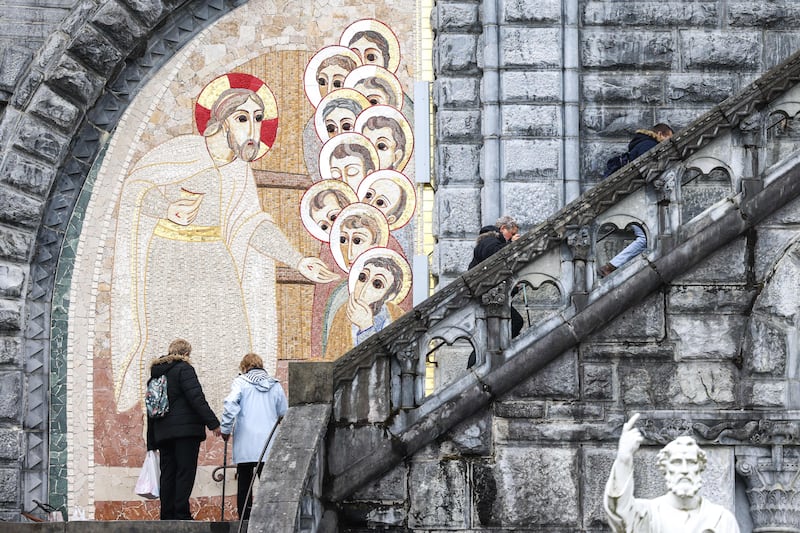Fr Marko Rupnik is probably the most influential religious artist in the world, famous for his large-scale mosaics that are found everywhere from the Vatican to Brazil. He is also the subject of dozens of allegations of sexual and spiritual abuse of religious sisters.
The Knights of Columbus, an influential US Catholic charity, announced last week that it would temporarily cover up Rupnik mosaics at two of its shrines. Depending on the outcome of an ongoing Vatican investigation, it may cover them permanently.
Earlier this month, the Bishop of Lourdes announced that Rupnik mosaics on the Basilica of the Rosary’s facade that are normally illuminated during torchlight processions will now be left in darkness. He would prefer to remove them and may do so in the future.
In the 1980s, Rupnik cofounded a religious order in Slovenia, the Loyola Community, with Sr Ivanka Hosta. Some of the allegations date from then even though they emerged into public awareness only a few years ago.
READ MORE
After a split with Hosta, Rupnik moved to Rome, where he became director of the Centro Aletti, a centre for art and spirituality.
Some of the Sisters from the original community continued to work with Rupnik in Rome and have made serious allegations of grotesque sexual and spiritual exploitation.
Yet again, the Church fails to understand the dynamics of abuse of power and sexual exploitation
Rupnik was ordained as a Jesuit and in 2018, his Order received allegations of sexual misconduct, including absolving someone in the confessional of sexual activity he had undertaken with them, a canonical crime which automatically leads to excommunication. https://www.americamagazine.org/faith/2023/06/22/marko-rupnik-abuse-timeline-245537
Rupnik was found guilty in 2020 and was duly excommunicated, but only for a fortnight. It is not clear why the sanction was lifted. Meanwhile, the Jesuits imposed restrictions on conducting public ministry, which he routinely flouted. The Jesuits expelled him in 2023, but he has been accepted by a Slovenian diocese.
The Bishop there declared that Rupnik has the right to be presumed innocent until proven guilty. Priests in Ireland are automatically removed from ministry when allegations are made.
The Vatican was asked to conduct an investigation. It initially refused because the allegations were outside the statute of limitations, but eventually began one. It is still ongoing.
In 2020, Bishop Daniele Libanori SJ, an auxiliary Bishop of Rome, was appointed to investigate the Slovenian community that Rupnik cofounded. Libanori uncovered numerous credible allegations against him. Some said that they first reported Rupnik 30 years ago, but were accused of being mentally unstable and unsuited to religious life.

The Loyola Community was dissolved in 2023 by the Vatican and sanctions were imposed on Hosta, the co-founder. The relative speed with which it was dissolved contrasts with the clean bill of health the Diocese of Rome gave to the Centro Aletti, the influential Roman art and spirituality centre directed by Rupnik.
The current director, Maria Campatelli, continues to defend Rupnik. She has called the allegations “defamatory and unproven” and accused the media of lynching Rupnik. He is still featured prominently on the website, including as dean of theology and director of spiritual art.
The Vatican’s Dicastery of Communications also continues to use Rupnik’s imagery on its website. When challenged, the director, layman Paolo Ruffini, declared that “removing, deleting, destroying art does not ever mean a good choice.” He referred to Caravaggio, who committed murder – should we remove his art?
In response, Boston’s Cardinal Sean O’Malley wrote to the Roman Curia, stating that “pastoral prudence would prevent displaying artwork in a way that could imply either exoneration or a subtle defence” of alleged perpetrators of abuse “or indicate indifference to the pain and suffering of so many victims of abuse”.
There was a time when I believed that art is separate from the artist, no matter how sick a human being the artist is. Reading credible accounts by both former and current religious sisters of the appalling manipulation and coercion carried out by Rupnik, including abuse carried out in sacred spaces or after celebrating the eucharist, I am no longer sure.
Some said that they first reported Rupnik 30 years ago, but were accused of being mentally unstable and unsuited to religious life
Neither Caravaggio nor his victims are alive. Rupnik and these alleged victims are. They have said that the abuse was central to Rupnik’s twisted spirituality and intrinsic to his creative process. They have not asked for the mosaics to be destroyed, merely to beremoved from places of worship and prayer.
The Church has caused untold harm by how it denied and covered up abuse of children. While progress has been made in some national churches, including Ireland, other cases emerge elsewhere with grim regularity. Increasingly, they involve abuse of adult women and men.
Yet again, the Church fails to understand the dynamics of abuse of power and sexual exploitation. It seems to be particularly unable to take seriously allegations of abuse of religious sisters.
There should be an immediate cessation of the use of the images on any Vatican or, indeed, any church communication. Pending the conclusion of the investigation, the mosaics should be covered as a mark of repentance for harm to victims of sexual abuse.
Covering up mosaics seems infinitely preferable to covering up crimes. If the allegations against Rupnik are proven to be correct, they should be permanently removed, as the victims have requested.














